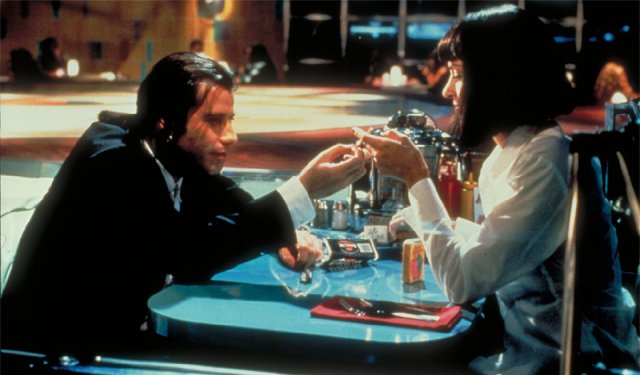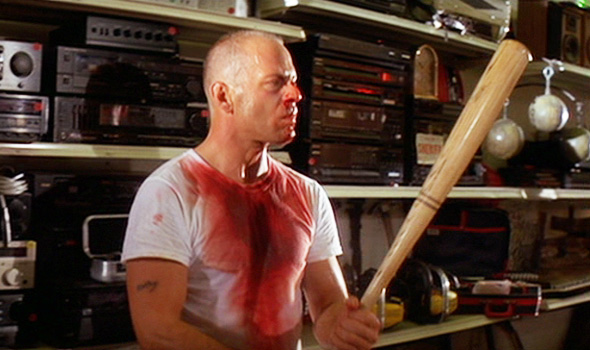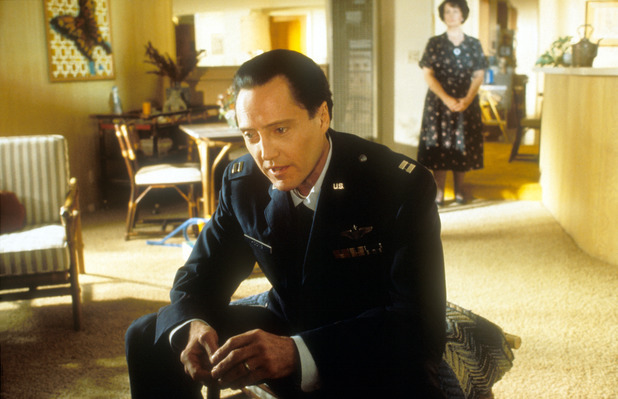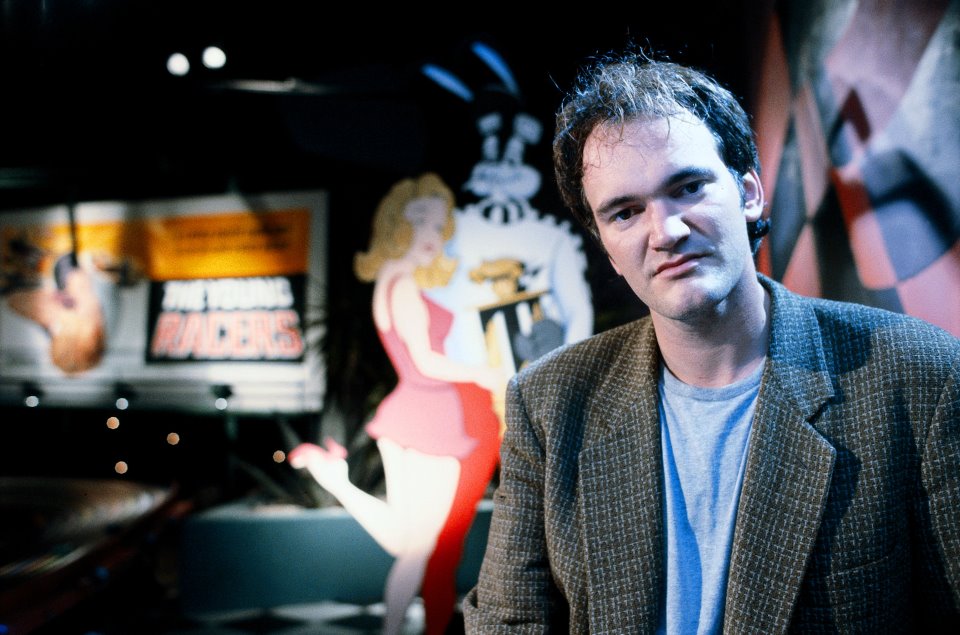4. Pop Culture Galore and The History of Film

One of the delights of any Tarantino film is the way the viewer can find, or discover for the first time, the wealth of pop references and homage’s built into the films. Pulp may well be the king of this aspect. Part of this has already been touched upon: the casting.
Perhaps it is a sort of wish fulfillment on the film maker’s part to hire those who might, many years ago, have enthralled him. However, there has never been an instance where this phenomenon comes across as “stunt casting”. Yes, bringing back those from the past who can serve as cultural flash cards may have a novelty appeal but they also call up associations which serve the film.
As noted, the big piece of casting here is John Travolta. His role of hip, drug loving hit man Vincent Vega carries a bit of the vibe of his character in Grease, had he gone very wrong in life, but, when he and mandatory date Mia (Thurman) visit the jaw dropping night club Jack Rabbit Slim’s and a dance contest is announced, which Mia demands to win, the viewer knows that Travolta will soon be out on the floor a la Saturday Night Fever (the joke is that he lost the contest in that film and won in this one).
Now, on the subject of the date, the dance, and the club there are several more references. The normally blond Thurman sports the dark bob which adorned US silent actress Louise Brooks (who found fame in Europe, where Vincent has just spent several years). Also, the 70’s Jerri-curl do that Vincent’s partner Jules sports is surely a blaxplotation reference.
While Vincent’s part of the dance is admittedly based on Travolta’s own film history, Tarantino admitted that he told Thurman to model her half on that on characters in the Walt Disney animated film The Aristocats (1972)! The fact that the two are dancing to a vintage hit by Rock “N Roll legend Chuck Berry is not an idle choice, either. (To state the obvious, Tarantino also has an uncanny knack for using popular songs on the soundtrack, not unusual in current cinema. However, the film maker can make those choices as living a part of the film as any of his other choices. There is, in fact, an entire TOC list dedicated to this component.)
In fact, the whole of Jack Rabbit Slim’s is one big vintage Easter Egg hunt. The décor is composed of period furniture from the 50s and early 60s ranging from the tables and chairs which would have adorned fast food joints, to diner staples and exhibits from finer dining establishments.
The wait staff is all made up to represent icons of the period with such people as Marilyn Monroe, Mamie Van Doren and Buddy Holly attending (and many miss that the waiter version of Mr. Holly is an uncredited Steve Buscemi). The menu is composed of fare with movie related names as description (milk shakes are either Amos “N Andy for chocolate or Martin “N Lewis for vanilla and the ordered “Douglas Sirk” steak can only be as vibrantly rare as that auteur’s vivid melodramas).
By the way, a commercial concern tried to recreate a real-life version of Silm’s but found that some things can only exist in the movies. Past that, the mysterious briefcase that haunts the stories perplexed those who didn’t know their film history but those who did recognize the reference as coming from the film noir classic Kiss Me Deadly (1955), with its unforgettable box of atomic power.
Even the cartoon the young Butch watches in his childhood flashback is an homage and has meaning. Those around at the time or who know their cartoon history would recognize the notoriously minimalist Clutch Cargo, in which human lips were superimposed over virtual still pictures to create an early TV version of an animated cartoon. Given the tough, spare Butch and the adventure he will soon embark upon, this seems quite appropriate.
While these sorts of hidden treasures can’t, in and of themselves, make a film, they can add immeasurably to it when used in a knowing way. Tarantino is perhaps the past master of this working in film today. Unlike so many younger film makers, he knows film history, loves film history and will use film history. In the end, he is a cinephile’s cinephile.
5. Stylized Violence and Deeply Pragmatic Philosophy

When Pulp first came out, there was a lot of talk centering on what was considered the excessive use of violence in the film. Now, a few things should be addressed about this up front: firstly, compared to many films made since, Pulp doesn’t seem all that violent now and, secondly, even so, though it still isn’t exactly mild or tame it is not grading on the curve.
One of the things many seemed to miss about the film and its violence is that Pulp is set in the criminal underworld. Two of the main characters are professional killers and they work for a big and very mean crime boss, who is married to another main character who is very much enjoying the fruits of criminal activity (especially illegal narcotics).
Even Butch (Willis), professionally a boxer, is tied to the crime world, hence the trouble he encounters when he sticks up for his own integrity and double crosses crime boss Marcellus (Rhames). Even all of this is not taking into consideration the doltish trio trying to pull a fast one on Marcellus in the first episode, the bone chilling people of the gun shop in the second and couple trying to practice the art of the hold up who are major players in episode three (and a few others living on the margins of society along the way).
Crime is, simply put, not a big deal to most of these people. Killing, torture, rape, drugs, theft… it’s all in a day’s work. However, not all of the characters will live and die by the sword and that is a major point many missed then and over the years.
Perhaps the finest performance in the film belongs to Jackson’s Jules, a hit man who can truly kill with the very best of them and who heightens the terror for his impending victims by reciting a mighty Bible verse is most thunderious manner. When he tells “Pumpkin” (Tim Roth) and “Honey Bunny” (Amanda Plummer), the too clever by half stick-up artists, that at another moment in time they would already be dead for fooling with him, the viewer doesn’t doubt it a bit.
However, just a few moments prior, he was telling the clueless Vincent that he had begun thinking more closely about the verse he uses as a prop in his work and the fact that there must be a better way to live somewhere. (Significantly, he is missing from episode two, the last one in the film chronologically).
Though the thought of these characters going by a traditional Judeo-Christian set of ethics is rather laughable, examining the film and sorting out the winners and losers among the characters makes it clear that the winners all have some sort of personal code of honor and ethics which informs their lives. Jules has that and, as episode two makes abundantly clear, so does Butch and even Marcellus.
Fearsome as he might be, Marcellus does have a code of conduct to which he will adhere and he does recognize his debt to Butch, though he must also keep Butch’s betrayal of him in the mix as well, albeit in a modified way. The bottom line about Marcellus and the other characters is that the code they display shows that piece is not a nihilistic, trashy film but one with a moral center, albeit morals existing within a specialized universe germane to the film. All of this helps to keep the film vital and alive after the visceral shocks wear off.
6. The Dialogue

Anyone who has ever seen Tarantino in one of his film cameos or on TV talk shows knows that this gentleman loves to talk. And talk. And talk. Therefore, it’s no surprise that very many of his characters love to talk as well.
Though Tarantino’s solid, colorful characters and scripts have already been noted, the dialogue is quite often what makes it all pop. In fact, for many, the calling card of Pulp was the conversation near the beginning wherein Vincent displays his knowledge of European vs. American culture by telling Jules that one can’t order McDonald’s Quarter Pounder with Cheese in metric-centric Holland and, thus, must request a “Royale with Cheese”.
It’s a funny little bit of dialogue but it also makes a point: dense Vincent absorbed nothing of European culture such as art, architecture, music, or social mores but he did note drug culture and fast food habits. In point of fact, the entire film overflows with dynamic conversations and monologues.
The film starts with ill advised exchange between the bandit couple in which they convince each other and themselves that robbing the coffee shop is a good idea (and come close to doing the same to the viewer).
There is also the conversation between Vincent and Jules once they get out of the car, chit chat concerning TV pilots and crime related gossip, which belies that they are on their way to performing a hit. Once that phase begins, Jules has his alternately hilariously funny and hugely frightening spiel to the ignorant yuppie upstarts, balanced out by his thoughtful discourse examining the words he often says for effect in the commission of his duty.
Add to that the dinner conversation between Vincent and Mia, drug dealer Lance (Stoltz) selling his heroin like he’s selling a Lexus or Mercedes while wife Jodi (Arquette) catalogs her numerous piercings to a new friend, Captain Koons (Walken) relating to the young Butch the story of his father’s watch, which sets the tone for the entire episode and also various other bits throughout the film.
The great thing, as with everything else about this film, is that it isn’t just showy, glib catch-phrase lines. The lines say very much about the characters and are always appropriate as to what that character would say.
The viewer should also keep in mind that long dialogue scenes are very dicey. If not handled correctly, they can easily become static and boring with no visual component. The fact that no viewer ever gets bored by these scenes in this film and Tarantino keeps them dynamic as much through words as acting, editing or camera movement. That is an achievement.
7. The Director

In every entry on this list the same name keeps coming up again and again… Quentin Tarantino. There was a time when most film goers seemed to think the actors just got in front of the camera and made it all up. In that era Alfred Hitchcock, Frank Capra, John Ford and Billy Wilder merged talent and personality to make such distinctive films that their names above even those of the stars could sell the film.
In the director-driven New Hollywood era people such as Scorsese, Francis Coppola, and Steven Spielberg duplicated that feat in modern terms. Tarantino came along in the post-Heaven’s Gate era when the director’s cultural currency had lost a lot of steam. He managed to resurrect it for himself through talent, quirky personality, love of film and, frankly, being in the spotlight every chance he got, and sheer force of will.
His is a story that inspires. Unlike the highly educated Scorsese, with his roots deeply in Catholic driven Italian-American New York City culture, Tarantino was like a flower which sprang up in dump. He was the child of a single mother, growing up near poverty in a culturally empty section of California.
His only education was his video store and what he gleaned from it. He wasn’t blessed with looks and socially he comes across as awkward and very geeky. One could imagine running from him at parties lest one be sentenced to hear a skewed version of the history of film at great length.
All of this is true but it overlooks that fact that he had passion, intelligence, and a talent which came out of virtually nowhere and which backs up his every lofty claim and fanciful idea. At first glance, one might well think that he would create shallow and worthless films but, happily, it isn’t so.
Even better, he has beaten the flash in the pan curse to prove himself a long range talent. Pulp was electric and many were awaiting more of the same with his subsequent film. However, when Jackie Brown (1997) premiered and was a slower, more consciously thoughtful, more overtly mature film, it disappointed the many. With perspective and overview, it now seems a brilliant choice in not trying to go bigger and broader and veering into burlesque.
The bottom line is that the real star of any Tarantino film is Quentin Tarantino. He has created a cinematic universe which is singular in its details, something only the best film makers can achieve. Though he continues to do good work and will surely keep going (though lately he says that after a few more films he will call it quits), Pulp will always be his big cultural calling card and a fine one it is indeed.
Author Bio: Woodson Hughes is a long-time librarian and an even longer time student/fan of film, cinema and movies. He has supervised and been publicist for three different film socieities over the years. He is married to the lovely Natalie Holden-Hughes, his eternal inspiration and wife of nearly four years.